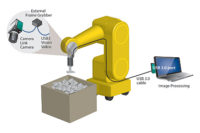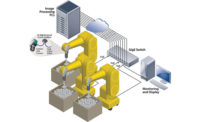
High-performance camera interface boards that comply with the GigE Vision standard allow video and imaging data to stream in real time over low-cost GigE networks. Source: Framos Imaging Solutions
When selecting an industrial camera, an important part of the job is choosing the video interface-the method used to transmit the imaging data to PCs or other system elements. It is a strategic decision with huge implications for the architecture, flexibility, scalability, cost and overall performance of the application. It also can be a daunting task. The highly competitive camera market offers a wide range of interface options, with a confusing array of performance claims.
Five years ago, the amount of bandwidth needed to stream data from a high-performance image sensor in real time seldom exceeded 1 gigabit per second (Gb/s). Since then, improvements in semiconductor processes and circuit design have yielded steady increases in sensor densities and frame rates, increasing demand for higher-speed camera interfaces.
The flat-panel digital sensors used for some diagnostic imaging applications, for instance, are producing image data at rates of more than 6 Gb/s. And the newest-generation complementary metal oxide semiconductor (CMOS) sensors for industrial inspection are offering SXGA resolution at 500 frames per second with 10-bit resolution, for real-time throughput of about 6.6 Gb/s.
While many of today’s applications do not yet require throughputs this high, they are an indicator of what is to come. It is a safe bet that interfaces without an evolution path to higher capacities are doomed to a slow demise, and systems that rely on them will need to be revamped.

Machine vision camera revenues in 2008 are shown here. Source: 2009 Automated Imaging Association Annual Machine Vision Market Study
Camera Link
Today, the highest-throughput camera interface with broad vendor support is Camera Link, the serial bus standard introduced in 2000 by the Automated Imaging Association (AIA). Camera Link is a commercial success, accounting for almost 25% of machine vision camera revenue in 2008.Camera Link transports data at up to 6.8 Gb/s over point-to-point, camera-to-frame grabber links of 10 meters or less. The short, 10-meter cable limit can be problematic. PCs are essentially tethered to cameras, restricting system design options. In some cases, this leads to situations where PCs are encased in expensive enclosures on dusty factory floors. Fiber optic extenders stretch the reach to 500 meters, but at a cost.
Camera Link connections also need a frame grabber in the PC-a drawback not shared by interfaces based on mainstream equipment. And finally, Camera Link’s dependence on legacy point-to-point topologies makes applications difficult to scale and does not accommodate architectures based on networked video.

These are key attributes of five competing high-speed camera interfaces.
Source: Pleora Technologies
CoaXPress
Last year, a small industry consortium unveiled CoaXPress, a proposal for a high-speed, asymmetrical serial standard that runs over coaxial cable. The proposal has since been handed to the Japan Industrial Imaging Association for standardization.CoaXPress supports a range of data rates over point-to-point connections. At the maximum rate, 6.25 Gb/s, the cable reach extends up to 40 meters. At the minimum, 1.25 Gb/s, the cable can be up to 120 meters long. To work, cameras must be equipped with a specialized proprietary line driver chip and PCs need a frame grabber with the companion receiver chip.
The chief advantages of CoaXPress over Camera Link will be its longer reach and lower-cost coaxial cable. However, like Camera Link, CoaXPress will be difficult to scale, deliver no support for networked video and use specialized hardware. At present, the two chips needed to support the implementation are available from only a single vendor.
Although field trials have begun, CoaXPress is still unproven and not yet standardized. For now, it is supported only by a small group of vendors and it is unclear at this point whether the products in field trials will comply with the final standard.

GigE Vision delivers full native support for networking in the seven-layer protocol stack for IP network communications. Source: Pleora Technologies
USB 3.0
Another emerging high-speed interface is USB 3.0, the super speed version of the well-known interface standard for linking computers and peripherals. Cameras with USB 2.0 ports have been around for several years, but with peak throughput of only 480 megabits per second (Mb/s), uptake has been limited.The USB 3.0 standard, finalized December 2008, offers usable throughput of 3.2 Gb/s and direct PC connections extend up to 3 meters.
Market adoption is expected to be slow, since Intel has announced it will not support USB 3.0 until 2011. Nonetheless, when the standard does go mainstream, the interface will be built-in on PCs, so no frame grabber will be needed, keeping cost down.
Lower costs are nice, but USB 3.0 will still have distance limitations and will not support video networking. Its star topology will allow one PC to support multiple cameras, but meshed network topologies will be out of the question.
In the industrial vision market, only one vendor has announced prototypes of a camera based on USB 3.0.
FireWire
IEEE 1394b, or FireWire, is a serial bus interface standard for video transmission between digital cameras and PCs. It has been used by industrial cameras since 2002, with commercial success. In 2008, it accounted for almost 30% of camera revenues.FireWire offers some plug-and-play capability with a built-in, low-cost PC interface. With its tree, star or ring topologies, up to 63 devices share 800 Mb/s (up to 640 Mb/s for a single camera). Adjacent devices can be separated by up to 4.5 meters, to a maximum of 72 meters with hubs.
FireWire offers some networking advantages over point-to-point interfaces such as Camera Link and CoaXPress because it allows many cameras to be interconnected. However, its relatively limited bandwidth-already inadequate for many mainstream sensors-is shared among all cameras.
In 2008, the IEEE introduced two higher-speed versions of FireWire, S1600 and S3200, supporting data rates of up to 1.6 Gb/s and 3.2 Gb/s, respectively. However, Intel, Apple and other influential mainstream players have no near-term intentions of supporting S1600 and S3200, leaning instead toward USB 3.0. Many new PCs do not even support the 1394b version of the standard. Some industry observers say FireWire is dying a slow death.
In the industrial imaging sector, one vendor has demonstrated a system-on-a-chip for S3200 FireWire cameras, promising commercial availability by year’s end.

Cameras with GigE Vision interfaces leverage the advantages of Ethernet, the world’s most widely deployed networking platform. Source: Imperx Inc.
GigE Vision
The final contender for the high-speed interface market listed is GigE Vision, the AIA standard for transmitting video and control data over low-cost Ethernet networks. Since its introduction in 2006, dozens of machine vision vendors have unveiled GigE Vision-compliant products. In 2008, only two years after its launch, GigE Vision accounted for almost 10% of all machine vision camera revenues.GigE Vision brings to industrial imaging applications all the advantages of Ethernet, the world’s most widely deployed networking platform. Ethernet features dedicated, unshared links that scale seamlessly from 10 Mb/s to 10 Gb/s over 100-meter cable lengths. With switches or fiber, the reach is unlimited. Ethernet delivers unmatched networking flexibility over a well-understood infrastructure based on mass-produced chip sets, switches and cabling. Ethernet interfaces are either built into PC motherboards or delivered via standard network interface cards. Frame grabbers are not required.
GigE Vision also is compatible with GenICam, the generic camera control interface administered by the European Machine Vision Association. GenICam allows a single application programming interface to control any compliant camera, simplifying the design of applications built around GigE Vision products.

GigE Vision now supports new types of network elements, such as video receivers that display video streams directly on standard monitors, without the need for PCs. Source: Pleora Technologies
Networked Video
GigE Vision Version 1.2, ratified in January 2010, extends the scope of the standard to support networked video architectures. GigE Vision is the only interface that delivers full native support for the seven-layer protocol stack for IP network communications.In practical terms, this means the GigE Vision framework now supports networked video connectivity solutions that go well beyond traditional point-to-point, camera-to-PC applications. It allows GigE Vision to accommodate growing market demand for advanced architectures with a richer variety of video network elements.
One new type of network element that recently came on the market is a video receiver that displays GigE Vision video streams directly on standard monitors, without the need for PCs. Other new elements supported by Version 1.2 are video servers, video processing units, management entities and network-controlled devices.
Under Version 1.2, these products can be networked with cameras and PCs in flexible, fully featured, GigE Vision-compliant video distribution architectures. Imaging data can be multicast, for example, from one camera to multiple PCs for processing and multiple video receivers for real-time display.
Other possible configurations are multiple camera systems, where data from one camera is sent for real-time processing and display and from another to a storage device, or where data from multiple cameras is sent to multiple PCs for distributed processing.
In terms of bandwidth, today’s GigE Vision cameras support throughput of up to 1 Gb/s, and the first 10 Gb/s video network elements are already being demonstrated. The AIA’s GigE Vision technical committee is working on Version 2.0 of the standard. When released next year, Version 2.0 will deliver a range of capabilities for higher-speed transport and formally include 10 GigE in the standard text. In the meantime, the standard does not preclude the use of 10 GigE. Expect to see GigE Vision products operating at 10 Gb/s before year’s end. V&S

